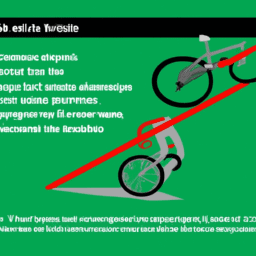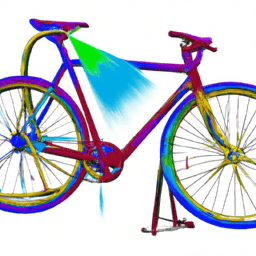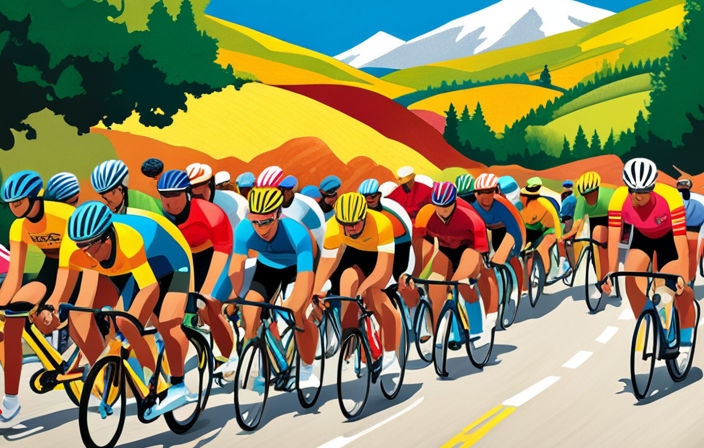Are you interested in discovering one of soccer’s most thrilling techniques? Search no more, because the bicycle kick is here. This dynamic move requires a player to jump, kicking the ball as they extend one or both legs backward over their head while in mid-air. Its showy nature and ability to score goals render it beloved by audiences and players alike.
While the bicycle kick may seem like a modern invention, its origins can be traced back over a century. The move is said to have been first performed by the Chilean soccer player Ramón Unzaga in the early 1900s. Since then, it has been used by players of all levels and has even made its way into other sports, such as volleyball and gymnastics.
If you’re curious about this impressive move and want to learn more about how to perform it, the benefits and risks involved, and some famous examples, keep reading.
Key Takeaways
- The bicycle kick is a technique in soccer where a player jumps and kicks the ball while in mid-air, often used for a spectacular goal.
- Proper technique and caution are important when attempting the bicycle kick, as there are risks and injuries associated with the move.
- Famous players who have executed the bicycle kick include Cristiano Ronaldo, Zlatan Ibrahimovic, and Pele.
- Coaches play a role in emphasizing proper technique and safety when attempting the bicycle kick.
Definition and History of Bicycle Kicks
If you’re a soccer fan, you’ve probably seen someone pull off a bicycle kick – it’s when a player jumps and kicks the ball over their head while in mid-air.
The origins of the bicycle kick are unclear, but it’s believed to have been first used in the late 1800s. The move has since evolved and become a staple in the game of soccer, with many professional players mastering the tricky maneuver.
The bicycle kick requires a combination of athleticism, timing, and technique. To perform the move, the player must jump into the air with their back facing the goal, then bring their legs up and over their head to make contact with the ball. It’s a risky move that requires split-second decision making, but when executed properly, it can result in a spectacular goal.
Now that you understand the history and evolution of the bicycle kick, let’s explore how to perform this impressive move.
How to Perform a Bicycle Kick
To execute a successful bicycle kick, you’ll need to position your body correctly, time your jump, and strike the ball with precision. Here are some steps to help you perform a bicycle kick:
- Stand facing the ball with your back towards the goal.
- Plant your non-kicking foot firmly on the ground and swing your kicking leg backwards to gain momentum.
- Jump off your non-kicking foot and simultaneously swing your kicking leg forward towards the ball.
- Make contact with the ball using the top of your foot, keeping your eyes on the ball at all times.
Bicycle kick variations include the scissor kick, where the legs cross over each other, and the overhead kick, where the player flips upside down to strike the ball.
Common mistakes in performing bicycle kicks include mistiming the jump, failing to make contact with the ball, and losing balance mid-air.
Performing bicycle kicks can be risky, but they also have benefits.
Benefits and Risks of Performing Bicycle Kicks
When it comes to performing bicycle kicks, there are both benefits and risks to consider.
Firstly, the effectiveness of scoring goals with a bicycle kick is undeniable.
However, the potential for injury is also high, particularly if proper technique is not followed.
Therefore, it’s important to weigh these factors carefully before attempting a bicycle kick on the field.
Effectiveness in Scoring Goals
Although bicycle kicks are considered flashy and difficult, they have a lower success rate in scoring goals compared to other techniques. This is because the execution of a bicycle kick requires an immense amount of skill, timing, and coordination.
Additionally, goalkeepers have developed strategies to counter this move, making it less effective in scoring goals. For example, goalkeepers can position themselves to block the shot or catch the ball before it reaches the net.
Moreover, another factor that limits the effectiveness of bicycle kicks is defensive limitations. Defenders can anticipate the move and position themselves to block the shot or disrupt the attacker’s balance, making it harder to execute the kick properly.
Therefore, while bicycle kicks can be a showstopper and a crowd-pleaser, it’s not always the most practical way to score a goal. Thus, in the next section, we’ll discuss the potential for injury when performing bicycle kicks.
Potential for Injury
Like a high-stakes game of Jenga, attempting acrobatic maneuvers on the field can lead to a delicate balance between victory and injury. The bicycle kick, in particular, poses a risk to the player attempting it.
Common injuries associated with the bicycle kick include strained muscles, sprained ankles, and even concussions. These types of injuries can occur when the player lands awkwardly or collides with another player while attempting the maneuver.
To prevent these injuries, players can engage in proper conditioning and stretching before attempting the bicycle kick. Additionally, coaches can emphasize proper technique and ensure that players aren’t attempting the maneuver recklessly. It’s important to note that while the bicycle kick can be a flashy and exciting way to score a goal, it’s not worth risking injury to attempt it without proper preparation and caution.
Moving on to the next section about famous examples of bicycle kicks, it’s worth noting that many of these examples showcase the beauty and skill of the maneuver without the added danger of injury.
Famous Examples of Bicycle Kicks
You’ll be in awe watching famous soccer players like Cristiano Ronaldo and Wayne Rooney execute incredible bicycle kicks during their matches. These kicks are considered one of the most difficult and impressive moves in soccer.
There are various bicycle kick variations, including the scissor kick, overhead kick, and the traditional bicycle kick where the player kicks the ball while jumping and flipping their body backwards.
Not only are bicycle kicks impressive to watch, but they also often result in amazing goals. When a player successfully pulls off a bicycle kick, it’s common to see them celebrate with a mixture of excitement and disbelief.
Bicycle kick celebrations can range from jumping in the air to sliding on their knees across the field. If you’re a soccer fan, keep an eye out for these incredible plays during matches.
With enough practice, you could even master the bicycle kick yourself. Next, let’s dive into some tips for mastering the bicycle kick and how to incorporate it into your soccer game.
Tips for Mastering the Bicycle Kick
To improve your chances of successfully executing the bicycle kick, it’s important to practice your timing and coordination. Studies have shown that players with better coordination are more likely to score goals.
One way to improve your coordination is to focus on your footwork. Proper footwork is crucial when attempting a bicycle kick. You should practice your footwork by doing various drills, such as dribbling around cones, hopping over hurdles, and jumping in place.
Another important aspect of mastering the bicycle kick is to avoid common mistakes. One common mistake is failing to properly position your body. To execute a successful bicycle kick, you need to position your body in a way that allows you to generate enough power to launch the ball towards the goal.
Another common mistake is not following through with the kick. You should make sure to follow through with the kick, extending your leg fully and keeping your eyes on the ball until it makes contact with your foot.
By practicing training drills and avoiding common mistakes, you can increase your chances of successfully executing the bicycle kick.
Frequently Asked Questions
What is the recommended age to start learning how to perform a bicycle kick?
To learn how to perform a bicycle kick, it is recommended to start training around the age of 10 or 11. Training techniques include practicing the motion of the kick, improving flexibility, and developing coordination and timing.
Can bicycle kicks be performed on any surface or only on grass fields?
To perform a bicycle kick, the surface suitability is important. It can be performed on any surface, but technique refinement is necessary to execute it properly on hard surfaces. Grass fields offer more give and are preferred.
Are there any specific muscles that need to be strengthened to perform a bicycle kick?
To execute a bicycle kick, you need strong core muscles, hip flexors, and quads. Strengthening exercises like planks, sit-ups, and squats can help. Proper technique involves timing, coordination, and balance, which can be developed through practice.
How long does it usually take to master a bicycle kick?
Mastering a bicycle kick can take several months of consistent practice. Benefits of the move include improved agility, balance, and coordination. Variations include the scissor kick and volley. Famous moments include Rooney’s goal against Man City and Zidane’s goal in the 2002 Champions League final.
Are there any common mistakes that beginners make when attempting a bicycle kick?
When attempting a bicycle kick, beginners often make the mistake of not properly positioning their body or failing to follow through with their kicking motion. Improving your form can prevent common injuries, such as strained muscles or twisted ankles.
Conclusion
Congratulations! You now know all about bicycle kicks and how to perform them properly. Remember, this move requires practice, patience, and physical fitness. With proper training, you can perfect this impressive maneuver that’s become a staple in the world of soccer.
However, it’s important to keep in mind that performing bicycle kicks carries certain risks, such as injury to the neck, back, and head. Always make sure to warm up properly, wear appropriate equipment, and perform the maneuver in a safe and controlled environment.
One example of a successful bicycle kick is the one performed by Cristiano Ronaldo during the 2018 UEFA Champions League quarter-final match between Real Madrid and Juventus. Ronaldo’s acrobatic goal, which helped lead his team to a win, was a perfect example of the technique and athleticism required to execute a bicycle kick successfully.
So, are you ready to try your hand (or foot) at this impressive move? Remember to start slow, take your time, and always prioritize safety above all else.
With practice, determination, and a little bit of luck, you too can become a master of the bicycle kick.
















